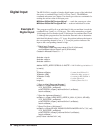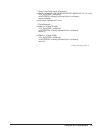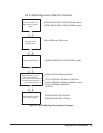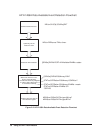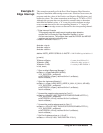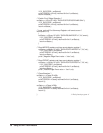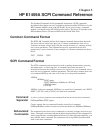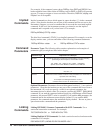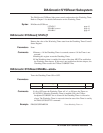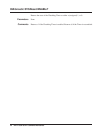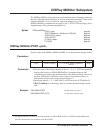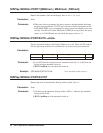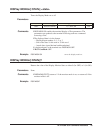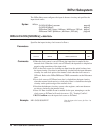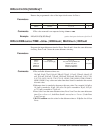
40 HP E1459A SCPI Command Reference
For example, if the command syntax shows DISPlay, then DISP and DISPLAY are
both acceptable forms. Other forms of
DISPlay, such as DISPL or DISPl will generate
an error. You may use upper or lower case letters. Therefore,
DISPLAY, display, and
DiSpLaY are all acceptable.
Implied
Commands
Implied commands are those which appear in square brackets ([ ]) in the command
syntax. (Note that the brackets are not part of the command and are not sent to the
instrument.) Suppose you send a command but do not send the associated implied
command. In this case, the instrument assumes you intend to use the implied
command and it responds as if you had sent it. For example:
DISPlay:MONitor[:STATe] <state>
The third level command [:STATe] is an implied command. For example, to set the
display monitor state, you can send either of the following command statements:
DISPlay:MONitor <state> or DISPlay:MONitor:STATe <state>
Command
Parameters
Parameter Types. The following table contains explanations and examples of
parameter types you might see later in this chapter.
Optional Parameters. Parameters shown within square brackets ([ ]) are optional
parameters. (Note that the brackets are not part of the command and are not sent to
the instrument.) If you do not specify a value for an optional parameter, the
instrument chooses a default value. For example, consider the
:PORT? [MIN | MAX]
command. If you send the command without specifying a MINimum or MAXimum
parameter, the present
PORT? value is returned. If you send the MIN parameter, the
command returns the minimum current display channel. If you send the
MAX
parameter, the command returns the maximum display channel. Be sure to place a
space between the command and the parameter.
Linking
Commands
Linking IEEE 488.2 Common Commands with SCPI Commands. Use a
semicolon between the commands. For example:
*RST;DISP:MON ON or DISP:MON ON;*TRG
Linking Multiple SCPI Commands. Use both a semicolon and a colon between the
commands. For example:
DISP:MON:PORT 0;:MEAS:DIG:DATA0:WORD::VAL?
Parameter Type Explanations and Example
Numeric Accepts all commonly used decimal representations of number including
optional signs, decimal points, and scientific notation.
123, 123E2, -123, -1.23E2, 0.123, 1.23E-2, 1.23000E-01.
Special cases include MINimum, MAXimum, and DEFault.
Boolean Represents a single binary condition that is either true or false.
ON, OFF, 1, 0
Discrete Selects from a finite number of values. These parameters use mnemonics to
represent each valid setting.
An example is the TRIGger:SOURce <source>
command where source can be BUS, EXT, or IMM.



